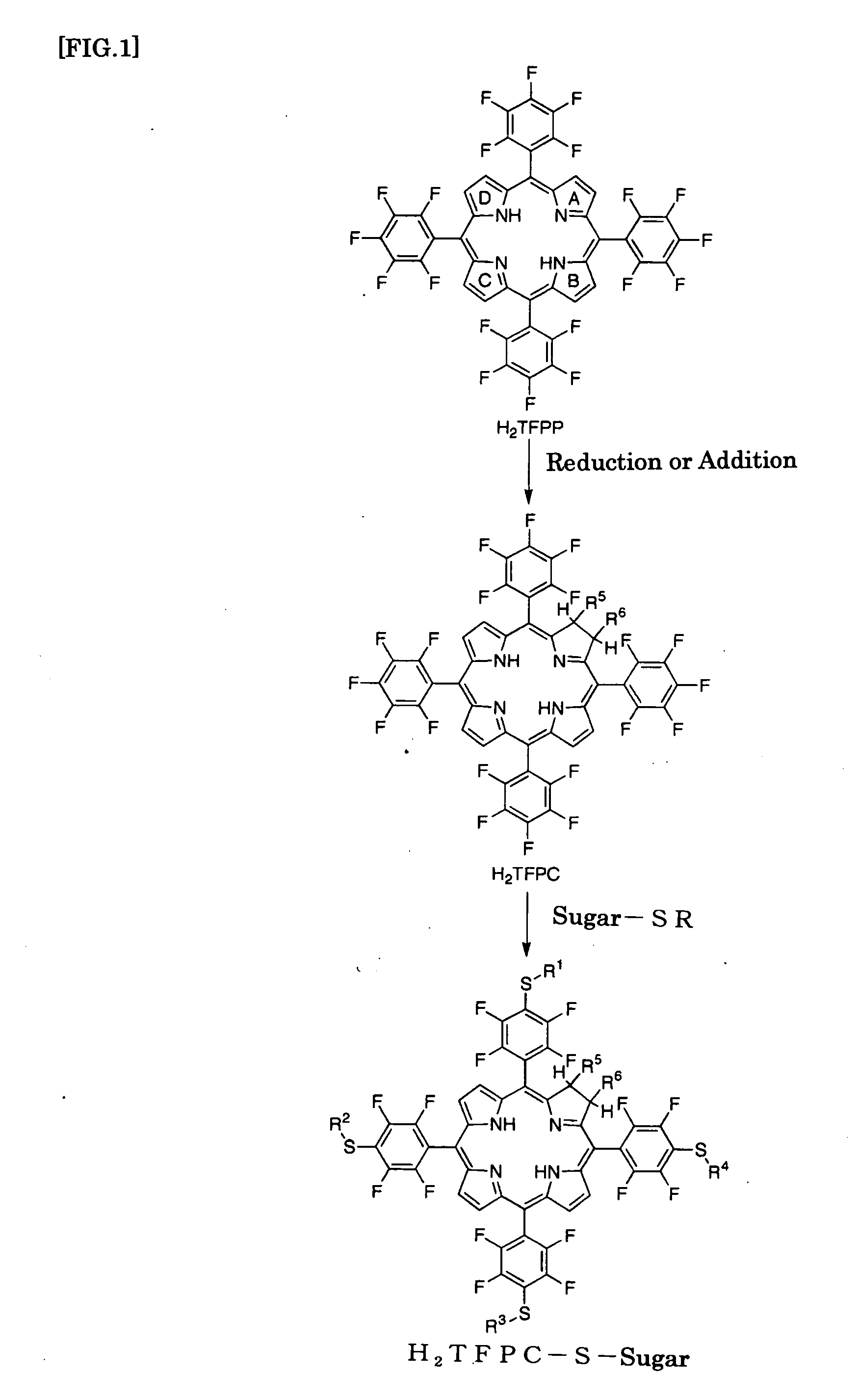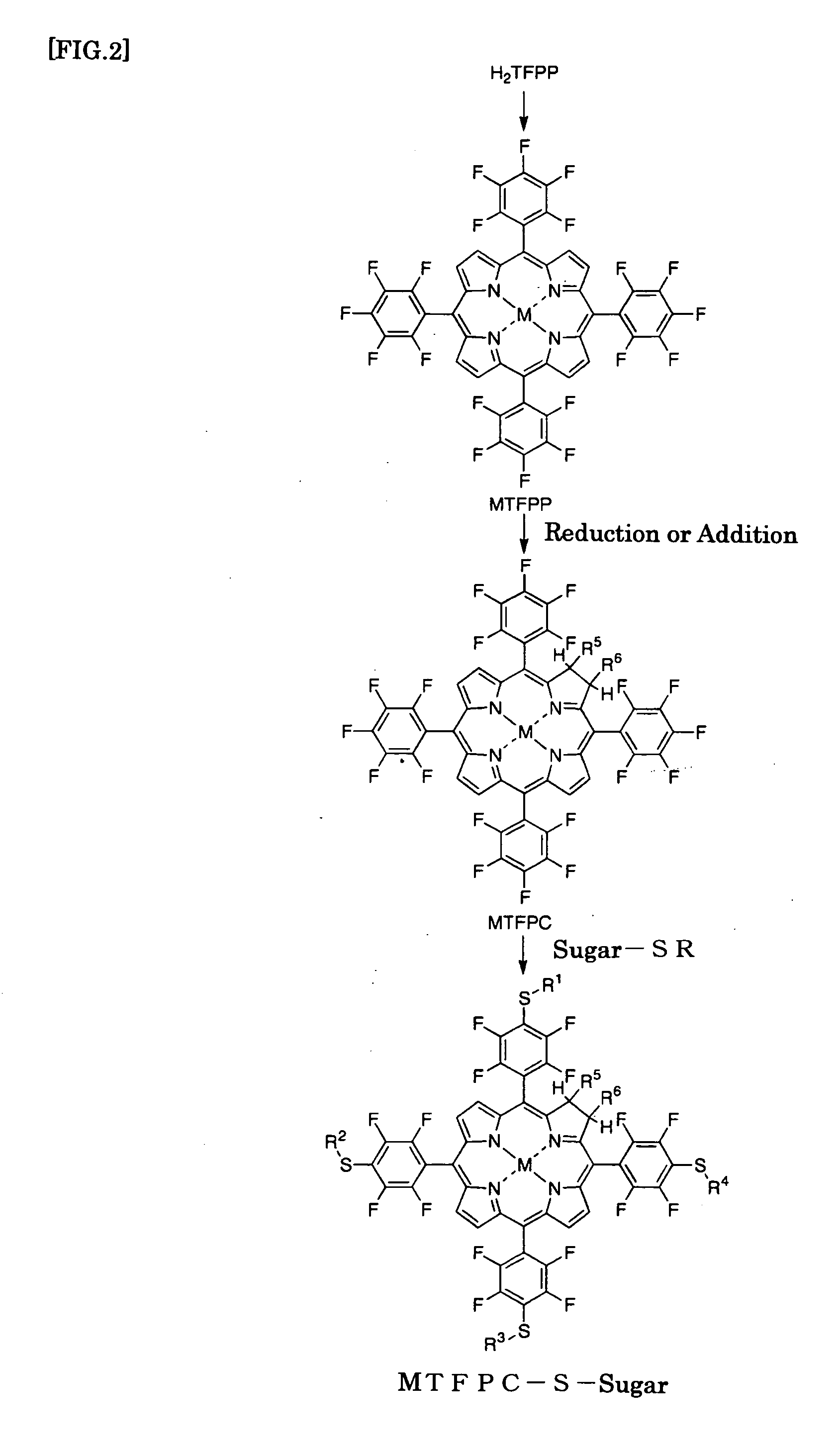Novel glycoconjugated chlorin derivatives and method of producing the same
a glycoconjugated chlorin and derivative technology, applied in the field of new glycoconjugated chlorin derivatives, can solve the problems of limited pdt treatment effectiveness and photosensitivity reaction, and achieve the effects of high melting point, strong cytotoxicity, and high productivity
- Summary
- Abstract
- Description
- Claims
- Application Information
AI Technical Summary
Benefits of technology
Problems solved by technology
Method used
Image
Examples
example 1
S-Glucosylated Chlorin Derivative
[0099](1) Preparation of H2TFPP (Synthesis of tetrakis(pentafluorophenyl)porphyrin Derivative)
[0100]Pentafluorobenzaldehyde (5 g) and pyrrole (2 mL) were dissolved in dichloromethane (1.2 L) under substitution with nitrogen. To the resultant solution was added boron trifluoride ether complex (1 mL) and heated under reflux for 4 hours, followed by addition of chloranil (6.9 g), and heated under reflux for another 12 hours. The resulting reaction mixture was cooled, concentrated under reduced pressure, and then loaded onto a silica gel column, and eluted with chloroform for preparative isolation to give 5,10,15,20-tetrakis(pentafluorophenyl)porphyrin (abbr. H2TFPP). After concentration under reduced pressure, it was recrystallized from the mixture of chloroform and methanol (yield: 3.8 g; 61%).
(2) Preparation of H2TFPC (Conversion from Porphyrin Derivative to Chlorin Derivative)
[0101]H2TFPP (892 mg) prepared in (1), N-methylglycine (171 mg) and parafor...
example 2
Pd Complex of H2TFPC-SGlc
(1) Preparation of PdTFPP (Introduction of Metal)
[0105]H2TFPP (1 g) prepared in Example 1, (1) and palladium chloride (0.4 g) were dissolved in benzonitrile (35 mL). After the atmosphere was substituted with nitrogen, the resulting solution was heated at reflux under nitrogen at 220° C. for 96 hours. The resultant reaction mixture was cooled and then concentrated under reduced pressure. The resulting crude product was loaded onto an alumina column and eluted with chloroform for preparative isolation. Further isolation was performed by silica gel chromatography and the resulting product was concentrated under reduced pressure, followed by recrystallization from a mixture of dichloromethane and methanol to provide [5,10,15,20-tetrakis(pentafluorophenyl)porphyrinato]palladium (II) (abbr. PdTFPP) (yield: 0.76 g; 70%).
(2) Preparation of PdTFPC (Conversion from Porphyrin Ring to Chlorin Ring)
[0106]PdTFPP (0.4 g) prepared in (1), N-methylglycine (0.2 g) and parafor...
example 3
H2TFPC-SGal
[0109]Example 1 was followed except that 2,3,4,6-tetra-o-acetyl-β-D-galactopyranosylacetylthioacetyl (abbr. AcGalSAc) was used instead of AcGlcSAc in the S-glucosylation process of Example 1 (3) to give 5,10,15,20-tetrakis[4-(β-D-galactopyranosylthio)-2,3,5,6-tetrafluorophenyl]-2,3-[methano(N-methyl)iminomethano]chlorin of which sugar is galactose (abbr. H2TFPC-SGal) (yield: 86 mg; 84%).
[Preparation of Porphyrin Derivative]
PUM
| Property | Measurement | Unit |
|---|---|---|
| Wavelength | aaaaa | aaaaa |
Abstract
Description
Claims
Application Information
 Login to View More
Login to View More - R&D
- Intellectual Property
- Life Sciences
- Materials
- Tech Scout
- Unparalleled Data Quality
- Higher Quality Content
- 60% Fewer Hallucinations
Browse by: Latest US Patents, China's latest patents, Technical Efficacy Thesaurus, Application Domain, Technology Topic, Popular Technical Reports.
© 2025 PatSnap. All rights reserved.Legal|Privacy policy|Modern Slavery Act Transparency Statement|Sitemap|About US| Contact US: help@patsnap.com



